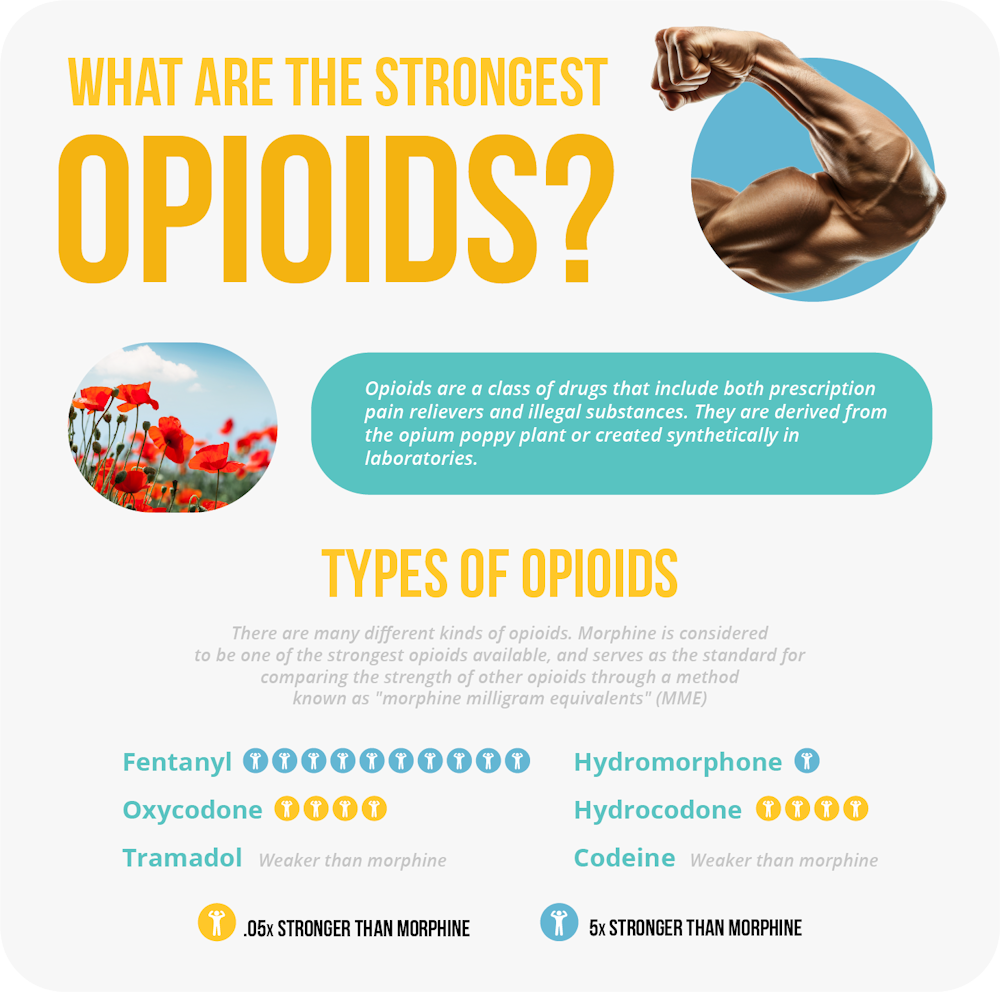When it comes to prescription drugs, opioids are notorious for being the strongest and most addictive. As a result, many individuals become addicted and actively struggle with substance use disorder. There are just as many people, however, who aren’t familiar with opioids such as: what they are, how they work, and what they’re prescribed for.
There are many kinds of opioids. Some are stronger than others, and some are weaker than others. However, the danger of addiction and abuse is still real. This is why it is imperative to understand why opioids are dangerous, and, without proper supervision, could prove to be deadly.
The List of Opioids: Strongest to Weakest
Jump to Section
Morphine
Morphine is considered to be one of the strongest opioids available. It is a naturally occurring substance found in the opium poppy plant and has been used for centuries to alleviate pain. Morphine works by binding to opioid receptors in the brain and spinal cord, which can block pain signals and produce feelings of pleasure and relaxation. This drug is commonly used to treat severe acute or chronic pain, such as that caused by cancer or after major surgery. However, it also carries a high risk of addiction and abuse, so it should only be used under close medical supervision.
Fentanyl
Fentanyl is a synthetic opioid that is 50-100 times more potent than morphine. It is often used in hospitals as an anesthesia for surgeries or to manage severe pain in cancer patients. Recently, there has been a surge in fentanyl use and abuse as it is being illegally manufactured and sold on the streets. This drug can be deadly even in small doses, so it should only be taken under strict medical supervision.
Hydromorphone
Hydromorphone, also known as Dilaudid, is another potent opioid that is frequently used to treat severe pain. It is about 5-7 times stronger than morphine and can produce intense feelings of euphoria and sedation. However, it also has a high potential for addiction and abuse, so it should only be used under close medical supervision.
Oxycodone
Oxycodone is a semi-synthetic opioid that is commonly prescribed for moderate to severe pain. It is about 1.5-2 times stronger than morphine and works by binding to opioid receptors in the brain and spinal cord. Oxycodone is available in immediate and extended-release forms, with the latter used for around-the-clock pain management. Unfortunately, it has a high potential for abuse and addiction, so it should only be used as directed by a healthcare professional.
Codeine
Codeine is a naturally occurring opioid that is found in opium and is also produced synthetically. It is less potent than morphine, but it is still considered a strong opioid. Codeine is often prescribed for mild to moderate pain or as a cough suppressant. However, it can cause drowsiness, constipation, and respiratory depression, so it should be used with caution.
Hydrocodone
Hydrocodone is a semi-synthetic opioid that is commonly prescribed for moderate to severe pain. It is about 1.5-2 times stronger than codeine and works by binding to opioid receptors in the brain and spinal cord. Hydrocodone is often combined with other pain relievers such as acetaminophen or ibuprofen. However, it also has a high potential for abuse and addiction, so it should only be used under close medical supervision.
Tramadol
Tramadol is a synthetic opioid that is weaker than morphine but still considered a potent drug. It works by binding to opioid receptors in the brain and also inhibiting the reuptake of serotonin and norepinephrine, which can help alleviate pain. Tramadol is often prescribed for moderate to moderately severe pain and has a lower risk of abuse compared to other opioids. However, it can still cause side effects such as dizziness, nausea, and constipation.
What are Opioids?
Opioids are a class of drugs that include heroin, synthetic opioids such as fentanyl, and pain relievers available legally by prescription. These include oxycodone, hydrocodone, codeine, morphine, and many others. These drugs are chemically related and interact with opioid receptors on nerve cells in the body and brain. Opioids are commonly prescribed to manage acute and chronic pain, but they carry a risk of addiction and overdose when misused.
Opioids have a complex history dating back thousands of years. However, more recently (in the 19th century), the isolation of morphine from opium marked a significant moment in opioid history. It was used extensively to alleviate pain in the American Civil War, leading to the first wave of opioid addiction. In the 20th century, synthetic opioids like fentanyl were introduced, marking another milestone. The late 1990s saw pharmaceutical companies reassuring the medical community about the non-addictive nature of opioids. This led to widespread use and sparked the current opioid crisis.
How Do Opioids Work?
Opioids work by binding to specific receptors in the brain, spinal cord, and other areas of the body. They reduce the sending of pain messages to the brain and diminish the perception of pain. When these drugs bind to certain opioid receptors in the brain and spinal cord, they trigger a series of biochemical responses.
These responses block the sensation of pain by reducing the intensity of pain signals reaching the brain, thereby altering the brain’s interpretation and perception of pain. Simultaneously, opioids can also trigger the release of dopamine, a neurotransmitter responsible for feelings of pleasure and reward. This contributes to their potential for misuse or dependency.
What are the Different Kinds of Opioids?
There are several different types of opioids, all of which are known for their potent pain-relieving properties. These include natural opioids such as morphine and codeine, which are derived directly from the opium poppy. Semi-synthetic opioids, which are created in labs from natural opioids, include drugs like hydrocodone, oxycodone, and heroin. Synthetic opioids, entirely synthesized in labs, include medications like fentanyl, methadone, and tramadol. It’s important to note that while these substances can be effective in managing pain, they also have a high potential for addiction and should be used responsibly.
What are the Side Effects of Opioids?
Opioid medications, while effective for pain management, can have several side effects. These range from relatively mild symptoms to more severe side effects. Some of these include the following:
- Nausea
- Drowsiness
- Constipation
- Dry mouth
- Slowed breathing rate (can lead to death if not promptly treated)
Long-term use may result in physical dependence and addiction, a severe health disorder characterized by compulsive drug seeking and use. Adverse psychological effects, including depression and increased sensitivity to pain, are also associated with prolonged opioid use.
Additionally, opioid medications can have interactions with other drugs, including alcohol and sedatives, which can increase the risk of overdose. Long-term use of opioids has also been linked to hormonal changes and decreased immune function. This makes individuals more susceptible to infections and illnesses. Opioids also have an impact on cognitive function, leading to difficulties with memory and concentration.
What is Opioid Addiction?
Opioid addiction is a chronic disease characterized by an individual’s inability to stop using opioids despite the negative impacts on their health and daily life. This includes prescription drugs like morphine, hydrocodone, oxycodone, and street drugs like heroin. The compulsive use of these drugs alters the brain’s chemistry, leading to physical dependence and withdrawal symptoms when usage is stopped. Opioid addiction is a serious public health issue associated with a multitude of issues which include the risk of death from overdose, the spread of diseases like HIV, as well as social and economic burdens.
How Many People Suffer from Opioid Addiction?
3 million citizens of the United States currently suffer from opioid addiction. In addition to this, 16 million people around the world also suffer from opioid use disorder. There are also many who are dependent on heroin in the United States (500,000 to be exact). In short, opioid addiction remains a significant public health crisis, making the role of opioid rehab centers crucial.
More recently, nearly 1,619 died from an opioid overdose in 2021. This growing epidemic emphasizes the urgent need for comprehensive strategies and solutions to address opioid addiction. This starts with recognizing the signs and symptoms of opioid addiction.
Signs and Symptoms of Opioid Addiction
Opioid addiction, a serious public health issue, manifests in several signs and symptoms.
Physical indicators may include:
- Drowsiness
- Weight loss
- Frequent flu-like symptoms
- A particular sense of euphoria
Behavioral changes could involve:
- Decreased social or professional obligations
- Changes in habits or appearance
- Increased secrecy or solitude
In addition to this, there are also psychological symptoms of opioid addiction.
Psychological symptoms might include:
- Mood swings
- Increased anxiety or agitation
These symptoms may vary from person to person, and professional help should be sought when addiction is suspected.
Why are Opioids Prescribed so Often if They’re so Dangerous?
Opioids are frequently prescribed due to their potent pain-relieving properties. They are effective in managing moderate to severe pain, particularly in cases of acute pain such as after surgery. They are also used for chronic conditions like cancer where other pain relievers may not provide sufficient relief.
However, their use comes with significant risks including addiction and overdose, leading to the ongoing opioid crisis. It’s a delicate balance that healthcare providers must maintain between adequately managing pain and minimizing potential harm. It underscores the significance of careful monitoring and patient education when using these powerful medications.
How are Opioids Taken?
Opioids can be administered in several ways. They can be swallowed in pill or liquid form, injected into a muscle or vein, or inserted rectally as a suppository. Some opioids come in patches that stick to the skin, delivering the medication over time through the skin into the bloodstream. Certain types of opioids may also be smoked or snorted. This may include drugs like heroin, where heroin rehab have become essential.
The method of administration of opioids can influence the onset, intensity, and duration of the drug’s effects. For example, smoking or snorting opioids can produce a quicker onset of effects compared to oral ingestion. Some people may start using opioids through a prescription from their doctor for pain management.
What are the Strongest and Weakest Opioids?
The classification of opioids usually depends on their potency, which can be associated with their overall effect on pain relief. The strongest opioid in clinical use is typically recognized as fentanyl, necessitating the importance of a fentanyl rehab center. It is about 50 to 100 times more potent than morphine.
On the other end of the spectrum, Codeine is usually considered one of the weakest opioids, often administered for mild to moderate pain. It’s important to note that while Fentanyl provides significant pain relief, it also carries a higher risk of dependency and potentially harmful side effects if not used correctly. This underscores the need for specialized fentanyl and morphine rehab programs to assist individuals who may develop dependencies or addictions.
Codeine, while classified as an opioid, is considered one of the weakest due to its relatively low potency. It works by binding to opioid receptors in the brain, but it does so less effectively than more potent opioids, resulting in a more mild pain-relieving effect. Additionally, the body metabolizes codeine into morphine at a much slower rate compared to other opioids. This slow conversion results in a less intense effect on pain perception. Therefore, Codeine is often administered for mild to moderate pain and is typically not the drug of choice for severe pain management.
How Do You Safely Use Opioids to Manage Pain?
When using opioids to manage pain, it is critical to follow certain safety measures. First, always adhere to the prescribed dosage and schedule provided by your healthcare professional. Never take more opioids than instructed, even if the pain is severe. It’s also important to be open and honest with your healthcare provider about any other medications or substances you are using. This includes alcohol, as these can interact with opioids and raise the risk of side effects.
Additionally, avoid activities that require mental alertness. This could include driving or operating machinery. It’s imperative to not participate in activities like these until you are aware of how opioid usage affects you. Lastly, store opioids securely to prevent misuse by others, and never share your medication. It’s important to remember that while opioids can be an effective part of a pain management strategy, they must be used responsibly to mitigate risks.
Free by the Sea Can Assist with Opioid Addiction
Opioid addiction is a very real condition and is difficult to overcome without professional help. At Free By The Sea, we can help. If you or a loved one would like to find out more, contact us.

Dr. Richard Crabbe joined our team in 2019 as our psychiatrist and medical director. He attended the University of Ghana Medical School where he became a Medical Doctor in 1977. From 1978 through 1984, he was a medical officer in the Ghana Navy and provided a variety of services from general medicine to surgeries. He received his Certificate in General Psychology from the American Board of Psychology and Neurology in 2002.






